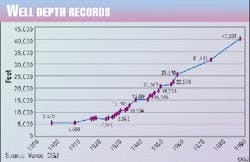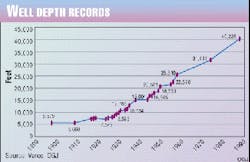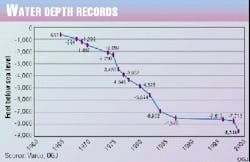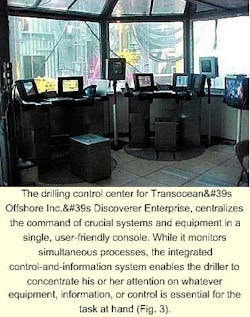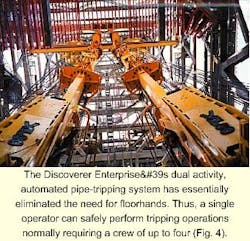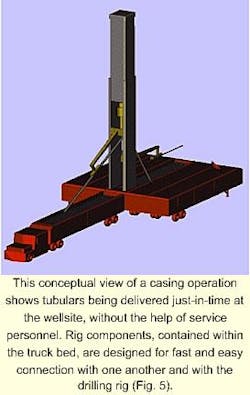In the 21st century, rapid advances in computer, robotic, and telecommunication technologies may remove drilling personnel from the wellsite, allowing remotely controlled or automated systems to perform the work traditionally supported by humans.
Unfortunately, as past predictions have shown, determining exactly what tools and techniques will be developed can not be answered with any level of certainty.
Two systems
It is interesting to note that over the past 100 years, the industry has employed only two basic drilling systems: cable tool and rotary.
Up until the 1920s, the former system, which involved pounding a hole in the earth with a heavy rod, dominated man's search for oil. Thus, aided by continued improvements in equipment design, cable tool drilling became an increasingly efficient technology, allowing drillers to reach depths up to 7,000 ft.
Nevertheless, hydraulic rotary drilling, a more efficient concept based on the use of surface-rotated, jointed drill pipe, slowly displaced cable tools, dominating western endeavors for the remainder of the 20th century.1
Along the way, engineers and drillers have also developed alternative and enhancing technologies for specific purposes, such as pneumatic drilling, jet drilling, rotary percussion drilling, downhole turbine and mud motor drilling, coiled-tubing drilling, laser drilling, and casing drilling. Yet if history is any guide, the basic concept of hydraulic rotary drilling will probably not be displaced any more than the Wright Brother's application of wings will be for flying.
The basic "axiom" of drilling supports this conviction - in order to drill through any material, the same amount of energy must be applied to the material as was used to form it in the first place. Thus, in most cases, where depositional systems altered by heat and pressure (energy) created the formations of the earth, drillers were forced to find the most efficient means to make hole.
The method they chose-applying energy to the formation through the rotation of large amounts of weight on the drill bit-became hard to beat in terms of efficiency. One simply needs to bore through a piece of steel with a hand drill to understand this principle.
There is a good example of this principle in use today. Up until 1980, the application of drilling torque and weight were more or less operationally limited by the use of drill pipe, kellys, drill bits, and rotary tables. For example, when there was a need to produce a large diameter hole, drillers commonly drilled a pilot hole of lesser diameter, then reamed it out to the full hole size.
As new advances came along, however, the industry began to replace rotary tables and kellys with high-torque top drives. At the same time, polycrystalline diamond compact (PDC) bits, which offer higher weight and torque capabilities, and larger diameter drill pipes, which utilize high-torque tool joints, made is easier to apply the necessary torque and weight needed to drill large diameter holes quickly.
Tools
Thus, although the basic drilling "axiom" has not changed, the industry has continuously altered many of its tools while inventing new ones along the way. Tool development is driven by economic and goal-oriented factors.
For example, many endeavors set out to reduce the cost of an activity, increase revenues, or both; while others attempt to achieve an objective that can not presently be done, such as drill in ultra-deepwater or in high-temperature, high-pressure environments (Figs. 1 and 2).
Many predictions exist on the limitations of oil left in the world (OGJ, Dec. 28, 1998, p. 33). It can be accurately concluded, however, that even though it is not known how much oil and gas is really left in the world, the industry will be driven to reduce costs or else some other abundant source of energy will take its place.
The computer
Over the next 100 years, computers will drill future wells much like they guide airplanes or operate factories. And computers have proven to be enormous reducers of cost and big generators of productivity. Thus, it can be realistically predicted that this technology will run drilling rigs in the next century, without human intervention.
In fact, some rigs are already moving in that direction such as the dual-activity, semi-automated Transocean Offshore Inc.'s Discoverer Enterprise (Fig. 3). With computers, the industry will solve the problem of retaining qualified personnel. And just as important, they will not have to work on rigs in remote areas of the world, leaving their families behind for weeks at a time.
Instead, they will remotely operate the rigs from air-conditioned offices in the same way scientists and engineers at NASA's Jet Propulsion Laboratory used the Sojourner Rover to explore Mars.
Why would an industry professional wish to work under such conditions, when there is no need to? Perhaps for no other reason than the oil worker's impulse to walk across the rig floor and look down the hole, even though it is visually impossible to see the drill bit and formations.
Automation
Along with remotely controlled rigs, the industry will develop new tools that can be easily controlled by computers. Today's automated pipe-handling equipment is a good example of what can be accomplished without human intervention.
For example, systems similar to the one shown in Fig. 4 can trip the entire drillstring without a floor crew, with the exception of a single floorhand who applies pipe dope to the threads while tripping into the hole.
Additionally, the mud system will no longer exist as a series of pits, tanks, pumps, and solids removal equipment, haphazardly scattered around the rig site and interconnected with a variety of pipes, cables, and channels. Instead, it will be replaced with a closed system that operates much like a refinery.
Chemicals and materials will be automatically inputted and well byproducts will be cleaned, dried, compacted, and packaged for disposal without human labor.
In addition to computers running the rigs of the future, they will also gather data traditionally gathered by other means. A major difference, however, will be that instead of looking at data from behind the bit and after the fact, geologists and engineers will look ahead of the bit in real time.
Thus, they will know where they are going before the well reaches TD. Other items that will be remotely identified will include the condition of the equipment, the status of the drilling program, and what materials will be needed for the well.
Casing, tubing, and completion equipment will be assembled and tested in a central completion facility based on real-time data obtained from the well. Tubulars will be delivered to the wellsite as needed and the rig will assemble production strings in the well without the presence of service personnel.
In fact, service providers, as they are known today, will become just-in-time suppliers of those goods and materials, not suppliers of experts at the wellsite.
Fig. 5 shows an artist's concept of such a rig. For example, the truck is supplying casing to the rig, which has been preassembled for running at the completion facility and delivered just-in-time.
In an offshore situation, the truck would be a container that is offloaded from a supply boat, then placed adjacent to the rig in a similar manner. Other rig components, designed for rapid and easy connection with each other, will be contained within the truck beds or cargo holds. In this way, the rig can be quickly moved and each module will be maintained at a central maintenance facility.
Crews
Drilling crews have undergone the least change in the last 100 years. Basically, drilling operations involve dangerous, dirty, and manually intensive procedures that have not been generally attractive to skilled workers.
The titles applied to drill crew members say it all: "worm, roustabout, roughneck, derrickman, motorman, driller, and tool pusher." These characters, from the 20th century, will be replaced with more appropriate titles such as " robotic technician and well manager," who will perform maintenance and oversee the operation.
Drilling specialists in the office (mission control) will drill the well from a remote location. Again, the industry is part way there. For example, some of the new rigs under construction are highly automated, as compared to previous designs. They can do many of the tasks that traditional crews have performed over the last 100 years.
The rigs will be very reliable by necessity and no maintenance will have to be performed at the rig site. Additionally, rig modules will be maintained at scheduled intervals in much the same manner as today's commercial transports (trucks and airplanes) are serviced.
The reliability of today's highway vehicles, as compared to 50 years ago, provides a good example of what can be accomplished.
And although offshore rigs by necessity may still have to be manned as vessels on the high seas, it is not too unrealistic to think of unmanned ships in the future. Perhaps, even offshore wells can be drilled with an automated vessel. After all, in deep water, personnel are already forced to work remotely with ocean floor robots.
Predictions
Based on the examination of past and current methods, tools, and crews associated with the drilling process, it is possible that:
- The basic concept of rotary drilling, as the most efficient technology, will not change.
- Rigs will not look much different from today's rig, yet they will be more compact and mobile.
- Specialists in central maintenance facilities will maintain rigs similar to those used in today's transportation industries.
- The primary new tools of the 21st century will be computers and machines run by computers.
- Traditional drilling crews will disappear and only technicians, responsible for monitoring a rig's systems and functions, will occupy the rigs.
- The operating cost of a rig will primarily be its capital cost.
Perhaps these changes will take longer than what most people think. However, it will happen much faster than the changes of the last 100 years have happened. In the end, we can only leave it to future historians to record the changes and analyze the results.
Reference
- Brantly, J.E., "History of Oil Well Drilling," Gulf Publishing Co., 1974
The Author
George Boyadjieff is chairman, CEO, and a director of Varco International Inc. He is an inventor with over 50 US patents to his credit and is most noted for his development of the top drive drilling system. Boyadjieff holds a BSME and MSME from the University of California at Berkeley and is a registered professional engineer in the State of California.
Additionally, he is a director of National Ocean Industries Assoc. (NOIA) and Petroleum Equipment Suppliers Assoc. (PESA). In 1990-91, Boyadjieff was selected as a Society of Petroleum Engineers distinguished lecturer.
